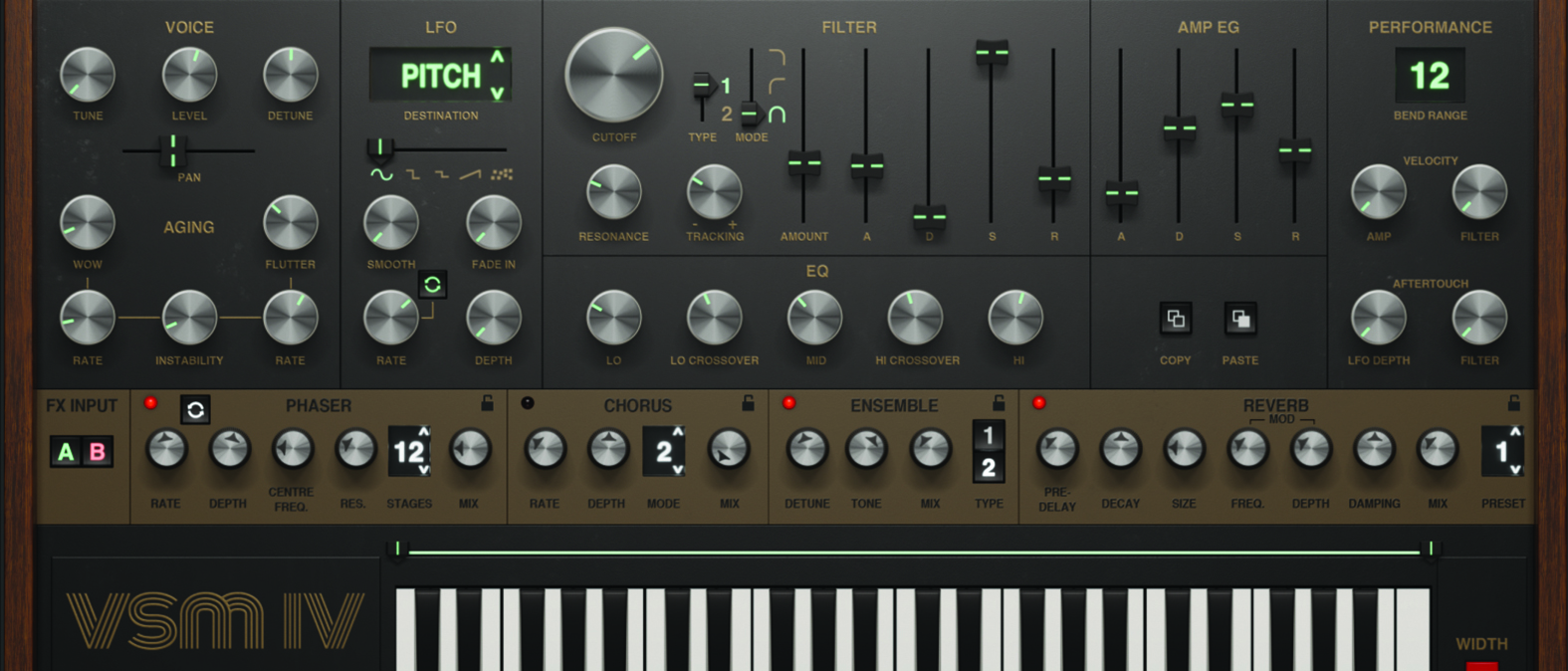MusicRadar Verdict
VSM IV hosts a huge collection of samples, drawn from the biggest and best crop of string machines and synthesizers with string-in-the-game. We dare you to use it without smiling!
Pros
- +
Beautiful-sounding collection of string machines and string-based synths.
- +
Programmability is highly flexible as well as engaging.
- +
Stunning array of samples, drawn from 46 original machines.
- +
It’s packed with useable patches.
- +
Exemplary Filter and Effects sections.
Cons
- -
The VSM interface colour could be more inviting!
MusicRadar's got your back
GForce Software VSM IV: What is it?
- macOS 10.13 or above. Intel & Apple Silicon Native, Standalone Application, AudioUnit, AAX, VST2, VST3.
- Windows 7 and above. 2GHz CPU with 2GB RAM. Standalone Application, VST, VST3, AAX.
- Buy at Plugin Boutique
Good news for those of you who like the sound of vintage synthesizers: you no longer have to run the gauntlet of the Wild West that makes up the secondhand synth market. With so many companies reproducing the classics, you could plump for a brand new hardware reissue, but what if you could purchase a piece of software that contained not just one classic machine, but 46 of them?
GForce Software continues to pull off a feat of engineering through its latest update to the incredibly appealing VSM series. String Machines are a class of electronic instrument with roots planted in traditional subtractive synthesis. But this does beg the question, why do they require a category of their own?
Back in the ’70s, when subtractive synthesis was still finding its mojo, the few polyphonic synthesizers that were available provided an unhealthy mixture of unreliability and extortionate price tags. Many artists yearned for the electronic sound, but in a polyphonic form which was not, at the time, catered for by the monophonic stalwarts, such as the Minimoog or ARP 2600.
As a direct response, the type of instrument known as the string synthesizer, or string machine, was born. These machines were stripped out affairs, offering up far more in terms of simplistic electronics and control, with reference to acoustic counterparts such as violin and cello. These sounds were often cast in electronic stone, being uneditable to any great degree, while also quite thin in texture. As a result, most of the machines would embrace audio thickeners, in the shape of chorus or ensemble effects.
This became a popular and burgeoning market for a concept which infiltrated the popular ’70s home organ market, as well as giving rise to a whole sector of standalone string machines from companies such as ARP, Elka, Roland, Korg and Yamaha, to name just a few. Their ability to play chords proved popular with artists as diverse as Jean-Michel Jarre, The Bee Gees, Joy Division and Radiohead, and many more besides.
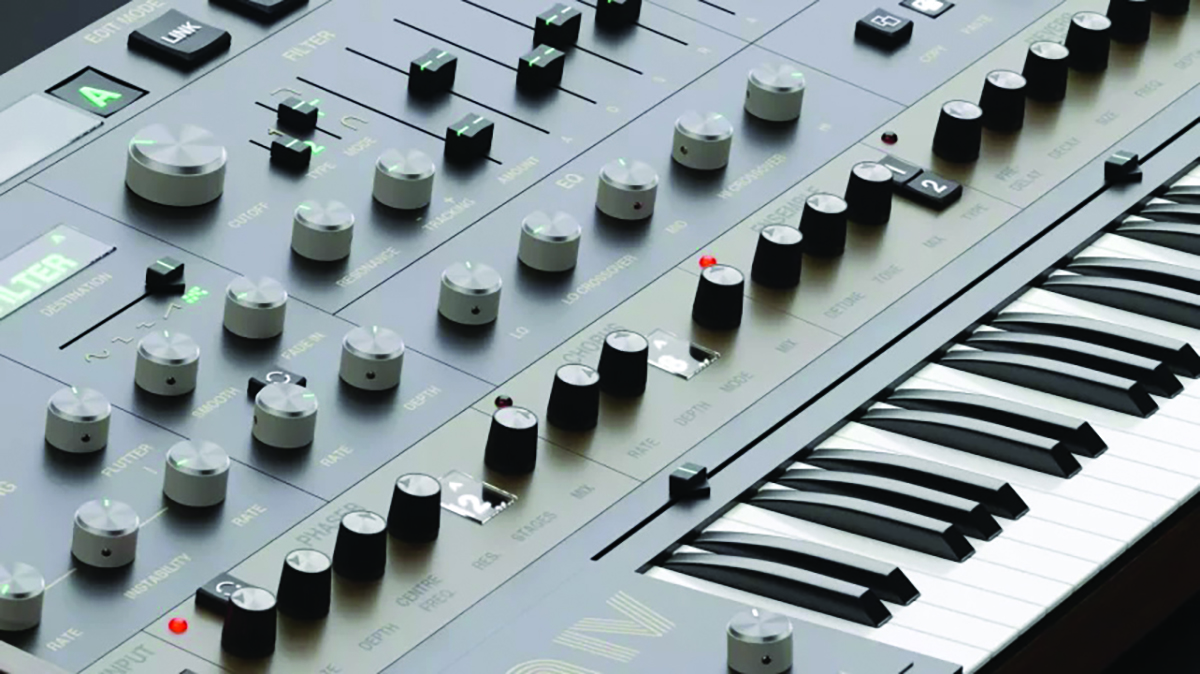
GForce Software VSM IV: Performance and verdict
As string machines continue to inspire contemporary artists across all genres of music production, the attractiveness of VSM IV is timely, permitting access to these classic sounds from a single inviting portal.
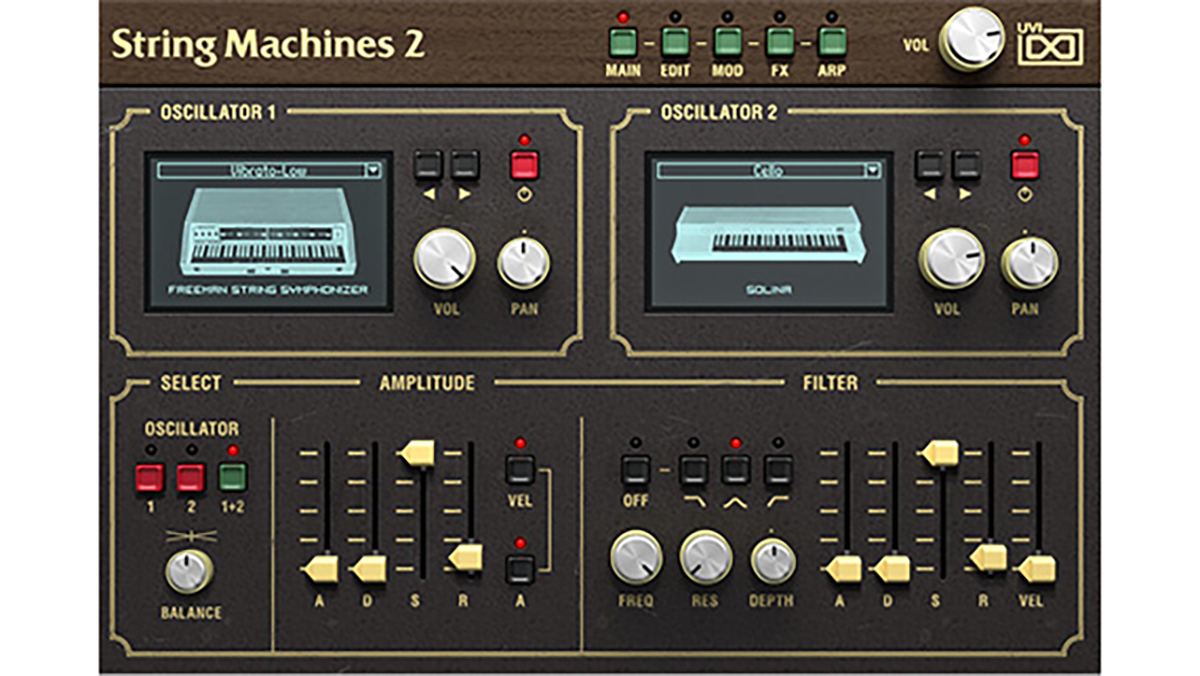
• UVI String Machines 2
This desirable sample collection provides similar functionality in a production-ready format.
• EastWest String Machine
This dedicated instrument provides a familiar interface for all of those classic String Machine sounds.
Anyone who has had experience with other GForce instruments will find navigation simple enough. At the very top of the plugin instrument, you gain access to an extensive set of editable presets. Thanks to its rigorous cataloguing system, you can find exactly what you require quickly and easily.
Want all the hottest music and gear news, reviews, deals, features and more, direct to your inbox? Sign up here.
The initial sound sources are sampled, captured from an extensive catalogue of 46 classic and rare electronic instruments. Many of these would be categorised as string machines, but there is also a sizeable contingent drawn from other machines, which adopt legendary string credentials. Given GForce’s product catalogue, Oberheim and ARP are evident, as well as the Mellotron. In terms of string machine models, there are plenty of included classics, such as the Elka Rhapsody, Logan String Machine and of course the ubiquitous Solina.
The hybrid Roland VP-330 Vocoder is also represented, but only by its onboard string sounds and not its endearing choir sounds. The more contemporary Waldorf Streichfett brings things up to date, and is heavily represented through a very large number of samples in various guises and registers.
The very nature of string machines means that some of the sounds can feel similar in make up, but the sampled content is a comparatively small part of the picture, thanks to VSM’s considerable options for building patches or editing existing presets. All of this is executed from the main user interface which provides the familiar construct of two equal layers, labelled A and B. Each layer hosts its own sample which is selected by the user, before heading through a familiar set of parameters. These include filter, two ADSR envelopes assigned to filter and amplitude, LFO, and a new and comprehensive three-band EQ.
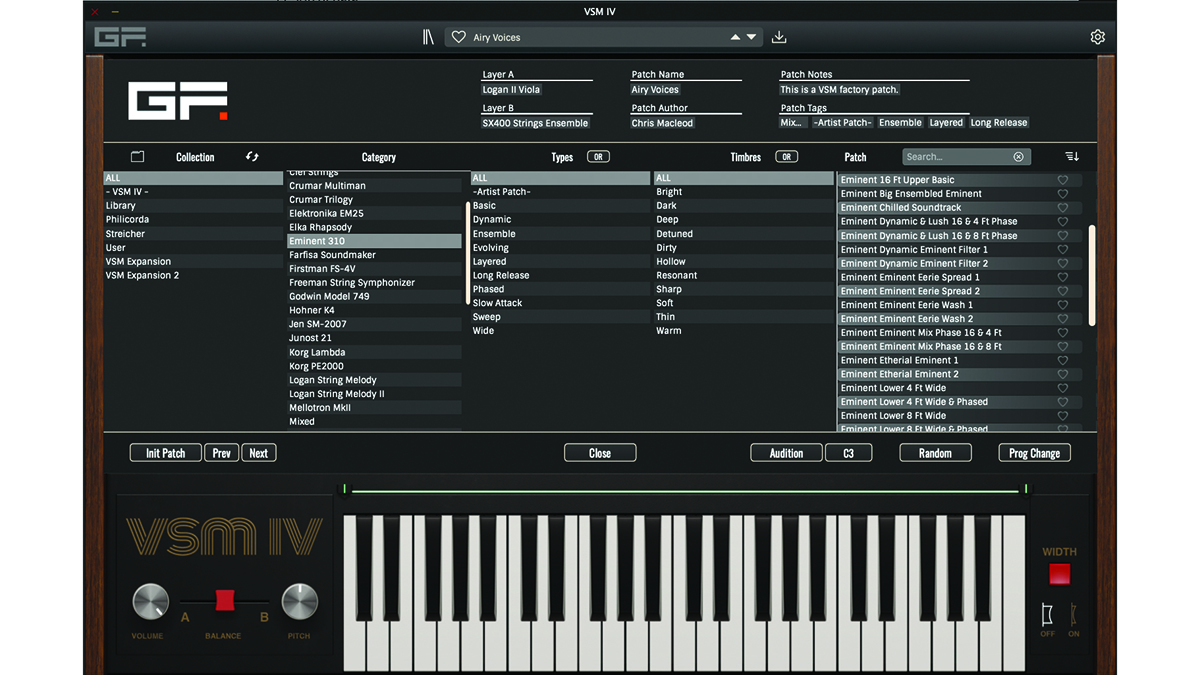
New strings to the bow
This update introduces some inevitable improvements, alongside some new components. Receiving a slight makeover, the patch browser makes navigation and patch selection incredibly easy, something which mirrors other recently updated products in the GForce catalogue.
The filter also receives a new tweak, in the shape of an additional state-variable mode. This is accessed alongside the usual low and high-pass options and provides a beautiful wispiness in sound, which feels reminiscent of Oberheim. We have to dwell on this for a moment, because the filter sounds absolutely stunning, while also providing a valuable resource for string sound patch creation. It’s often the case that employing some form of high-pass or band-pass filter can be beneficial to these forms of sound, so this new inclusion is very welcome indeed, as well as being exceptionally usable.

Another new addition to each layer is the Aging section, which allows the engagement of wow and flutter, as well as instability, to the sampled sound. In use, this means that you can create tape-based reminiscence, but with complete control over the amount that you wish to add. Moreover, because this is added at the layer level, it means that it can be used to thicken the overall texture, particularly if the opposite sample remains stable.
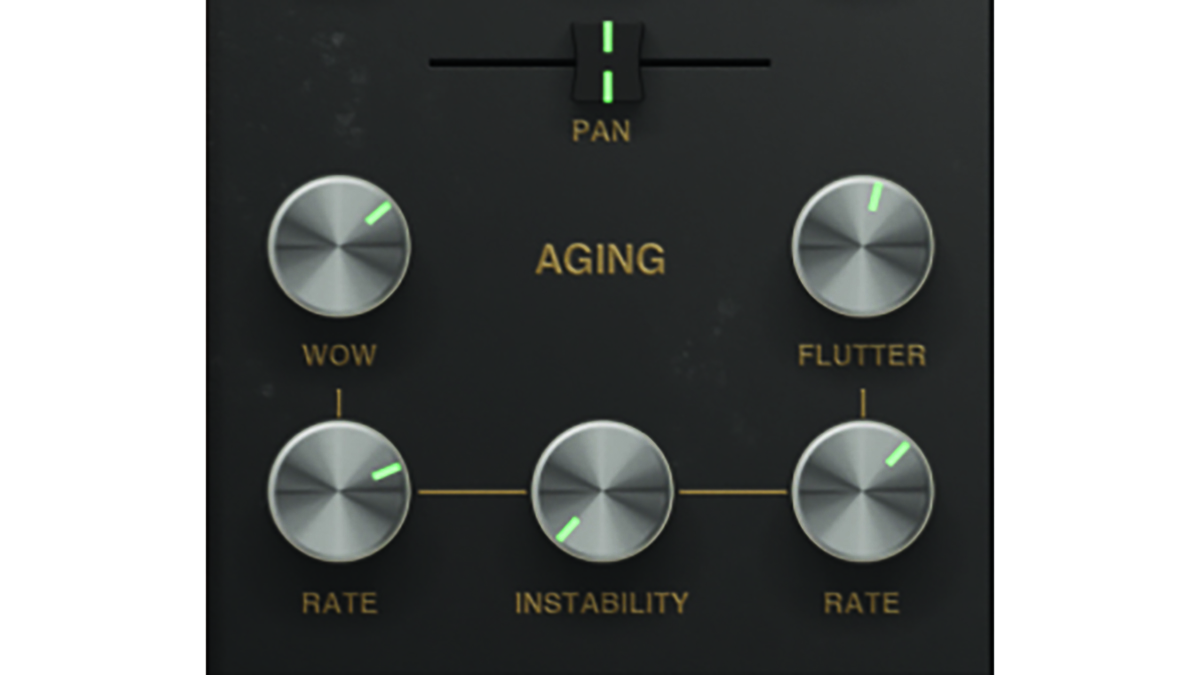
The effects section has received a major overhaul too, with the addition of a new chorus and matrix reverb effect, coupled with a very desirable ensemble effect. Effects routing remains quite flexible, with the capacity to blend each effect with the original dry signal, so that your patch doesn’t always have to end up being over-effected. The instrument user interface is also now fully scalable, so you can reduce the screen footprint or increase it to its maximum potential, if you just want to get buried in the sounds and programming.
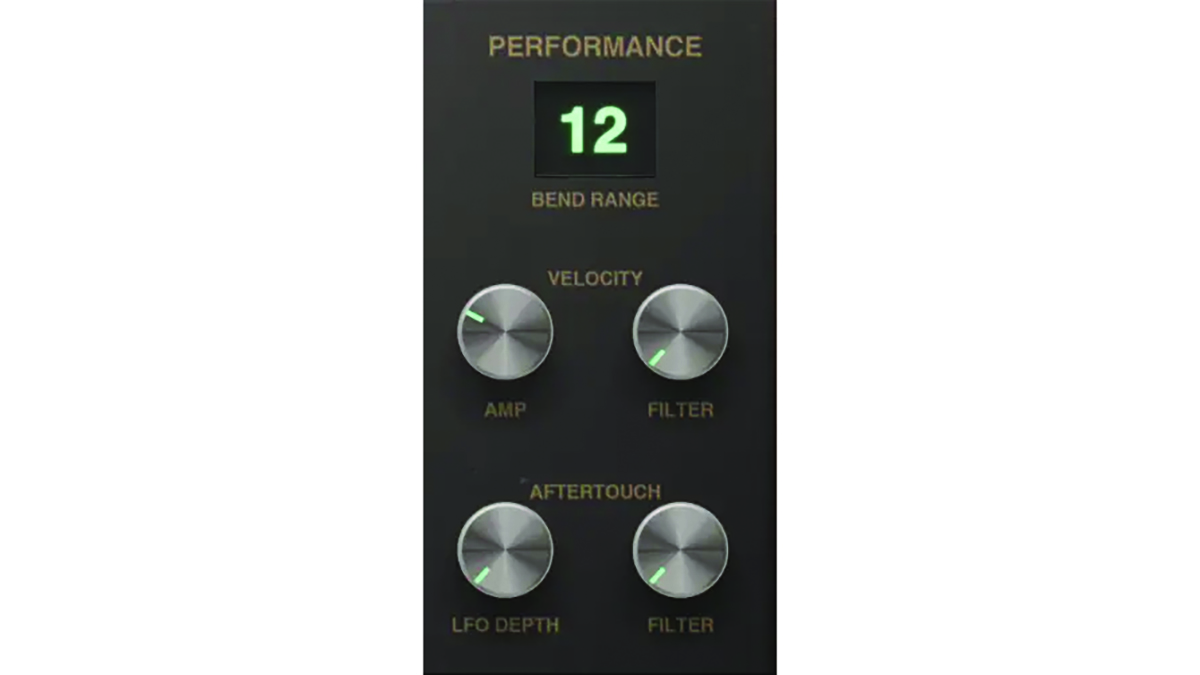
Rousing chorus
VSM IV is one of those wonderful instruments which is far more than its sum of parts. As GForce are purists and experts in the field of engineering classic instruments in software, the initial samples are absolutely stunning and provide the very best starting point, should you want to build patches from the ground up. With our purist’s head on, we really enjoyed auditioning the initial samples and hearing how radically they can become transformed.
The filter has a lot to answer for here; it is utterly beautiful, engaging and reminiscent of classic synth circuitry. The new aging section is also quite a triumph, as it acts as a sonic humaniser and thickener, adding significantly to the overall colour of the sound.
It’d be easy to lose yourself in these sounds, especially if you were to magnify the working area
The effect section also plays an enormous role in any string sound, with considerable options in this department, coupled by excellent quality. With a class of instrument that is so reliant on effects, it is nice to have these components available at source, whether you choose to employ them locally or access effects from within your DAW.
It’d be pretty easy to lose yourself in these beautiful sounds, especially if you were to magnify the working area on-screen. However, while it’s sonically a very firm cut above, the dark brown shading of the fascia does feel a little dowdy.
Our preference would have been to be offered some form of option to change the VSM’s colour, or make it a little more visually appealing. Don’t let this fool you though, VSM IV sounds every bit like a vintage string machine, and far more besides!
MusicRadar verdict: VSM IV hosts a huge collection of samples, drawn from the biggest and best crop of string machines and synthesizers with string-in-the-game. We dare you to use it without smiling!
GForce Software VSM IV: The web says
"As a big fan of the Virtual String Machine III, I am happy that GForce has made this version IV makeover. The new UI is night and day compared to the old one. It’s modern and more pleasing to look at. In terms of new features, it’s an excellent update. The new effects harmonize very satisfactorily with the engine."
Synth Anatomy
GForce Software VSM IV: Hands-on demos
GForce Software
Nu-Trix The Synth Guy
VST'S SOUNDS
Vulture Culture
GForce Software VSM IV: Specifications
- macOS 10.13 or above. Intel & Apple Silicon Native, Standalone Application, AudioUnit, AAX, VST2, VST3.
- Windows 7 and above. 2GHz CPU with 2GB RAM. Standalone Application, VST, VST3, AAX.
- CONTACT: GForce Software
Roland Schmidt is a professional programmer, sound designer and producer, who has worked in collaboration with a number of successful production teams over the last 25 years. He can also be found delivering regular and key-note lectures on the use of hardware/software synthesisers and production, at various higher educational institutions throughout the UK
